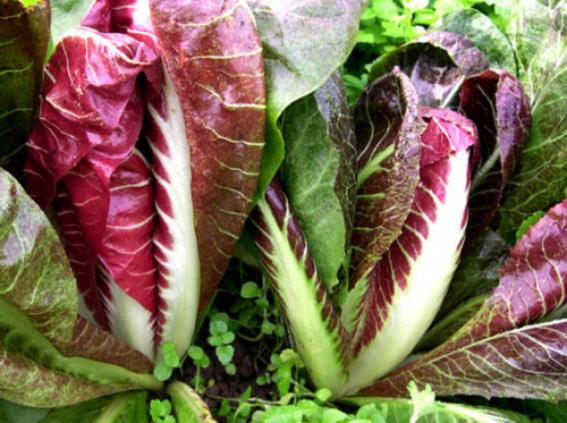
Video Guides
Need to build a raised bed? Or maybe you're battling those pesky slugs. We've got videos filled with easy and practical tips to help you in your veg patch.

Courses
Learn to grown, cook and eat some of your own food with our courses held at GROW HQ.

Chicory
Veg Type:
Leaves
Growing Location:
Indoors and Outdoors

A bitter leaved, tangy salad plant, chicory adds a nice texture to winter salads. There are three types: red chicory, often known as radicchio or Italian chicory; forcing chicory, which is ‘forced’ by depriving the plants of light to produce tender, sweet white growths called chicons (which are a lot like tender cos lettuce); and sugarloaf chicory, which is like lettuce.
Chicory can be grown in a raised bed or open ground, or even in a pot – so it’s ideal for the balcony grower. You can grow them as baby leaves or let them grow on to produce a compact head. Forcing chicory can often be the only way of having tender young salad leaves in a very cold climate, as you are forcing them indoors in pots – and the little chicons are a delicacy.
Recommended Variety
- Witloof de Brussels
- Red Treviso
- Pallo Rossa
Sowing
- Chicory can be sown direct or in module trays for transplanting.
- Sow indoors from March to July and outside from April to July.
- Sow a single seed in each module and lightly cover with compost.
- Sow outdoors thinly at 1cm deep in rows 25cm apart – sowing every two to three weeks will give you chicory throughout the summer.
Growing
- Transplant module-grown seedlings when they are 10-12cm tall. Space 20cm apart in rows 25cm apart.
- Thin direct sowings to the same spacing – thinnings can be used for salads, but may be too bitter for some.
- Make sure the soil doesn’t dry out, particularly after transplanting.
Harvesting
- You can start harvesting the baby leaves as soon as they are ready.
- Or leave to form a compact head – it will feel firm and plump to touch when it’s ready. Cut mature heads when ready.
- Dig up chicon roots in the autumn and transplant into containers. Place containers somewhere warm, in the dark and tender chicons will form over the winter – these can be cut off and eaten, and the process can then be repeated for spring.
TIPS
- Keep the soil evenly moist – plants that are stressed from lack of water produce bitter leaves
- The dried tap root of chicory can be ground and used as a substitute for coffee.
Problems
- Chicory is fairly trouble free, but slugs and leaf rots can be a problem.
- Make sure the plants are grown at the recommended spacing and keep the area slug free.
Our food system is broken and at GIY we believe that nurturing a real connection to where our food comes from is the key to fixing it.
We're on a mission to inspire a global movement of food growers, one GIYer at a time.
Sign up to be the first to hear about all things GIY.













